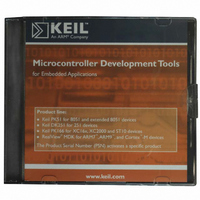MDK-ARM Keil, MDK-ARM Datasheet - Page 114

MDK-ARM
Manufacturer Part Number
MDK-ARM
Description
KIT REALVIEW MCU DEVELOPMENT
Manufacturer
Keil
Type
Compiler and IDEr
Specifications of MDK-ARM
For Use With/related Products
ARM MCUs
Lead Free Status / RoHS Status
Lead free / RoHS Compliant
- Current page: 114 of 156
- Download datasheet (3Mb)
114
Chapter 5. RL-USB Introduction
These logical pipes are
implemented on the
serial bus as time
division multiplexing on
the USB network. Each
pipe can make a data
transaction within a
frame. The bus is
precisely defined into
1msec frames. Every
1ms the host PC sends a
Start-of-Frame (SOF)
token to define the 12 Mbit/s bus into a series of frames. Each pipe is allocated a
slot in each frame, so that it can transfer data as required.
USB supports several different types of pipes with different transfer
characteristics. This is in order to support the needs of different types of
application. It is possible to design a USB device capable of supporting several
different configurations. These can then be dynamically changed to match the
running host application. The types of pipes available are: Control, Interrupt,
Bulk, and Isochronous. All of these pipes are unidirectional, except the control
pipe that is bidirectional. The Control pipe is reserved for the host to send and
request configuration information to and from the device. Generally, the
application software does not use it. The unidirectional pipes are defined as
either IN pipes, which transfer data from the device to the host, or OUT pipes,
which transfer data from the host to the device. When a device is connected to a
USB network, it will always assume network address 0. The host uses a
bidirectional control pipe to connect to Endpoint 0. The host and the device then
go through an enumeration process. During this process, information about the
USB device is sent to the host. The host also assigns the device a network
address. This keeps address 0 free for new devices.
The remaining types of pipe are used solely for the user application. Typically,
within the USB peripheral of a microcontroller the physical Endpoints are
grouped as logical pairs. Endpoint 1 will consist of two physical Endpoints. One
is used to send data in to the USB host and one is used to receive data out from
the USB host.
Related parts for MDK-ARM
Image
Part Number
Description
Manufacturer
Datasheet
Request
R

Part Number:
Description:
KIT REALVIEW MCU DEVELOPMENT
Manufacturer:
Keil
Datasheet:

Part Number:
Description:
Development Software SUPPORT EXTENSION FOR MDK-ARM-B
Manufacturer:
Keil Software

Part Number:
Description:
Development Software SUPPORT EXTENSION FOR MDK-ARM
Manufacturer:
Keil Software

Part Number:
Description:
KIT REALVIEW MCU DEVELOPMENT
Manufacturer:
Keil
Datasheet:

Part Number:
Description:
Development Software MCU DEV KIT FOR ARM UPG TO FLOATING LIC
Manufacturer:
Keil Tools

Part Number:
Description:
Development Software MCU DEV KIT FOR ARM W/ FLOATING LICENSE
Manufacturer:
Keil Software

Part Number:
Description:
Development Software MCU DEV KIT FOR ARM uVISION & C++ & RTX
Manufacturer:
Keil Tools

Part Number:
Description:
Development Software SUPP LICENSE RENEWAL 90+ DAYS NO TECH SUP
Manufacturer:
Keil Software
Part Number:
Description:
KEIL C-COMPILER INTERNATIONAL
Manufacturer:
Silicon Laboratories Inc

Part Number:
Description:
BOARD EVAL FOR LPC213X ARM MCU
Manufacturer:
NXP Semiconductors
Datasheet:
Part Number:
Description:
K60N512 Keil Tower Kit
Manufacturer:
Freescale Semiconductor
Datasheet:










